Siemens Desiro
The Siemens Desiro is a family of diesel or electric multiple unit passenger trains developed by Siemens Mobility, a division of the German Siemens AG conglomerate.[1] The main variants are the Desiro Classic, Desiro ML, Desiro UK and the later Desiro City, Desiro HC and Desiro RUS. The trains are mostly used for commuter and regional services,[1] and their rapid acceleration makes them suitable for services with short distances between stations. The design is flexible, and has become common in many European countries.
| Siemens Desiro | |
|---|---|
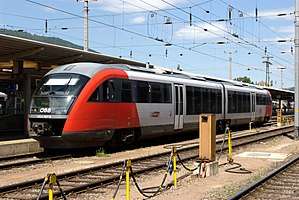 Desiro train in Graz, Austria | |
| Manufacturer | Siemens Mobility |
| Family name | Desiro |
| Specifications | |
| Maximum speed | 160 km/h (99 mph) (180 km/h [110 mph] in Desiro UK) |
| Track gauge | 1,435 mm (4 ft 8 1⁄2 in) standard gauge |
Desiro Classic
Austria
Austrian Federal Railways (ÖBB) is using about 60 diesel-powered Desiro trains designated as ÖBB 5022. These are based on the Class 642 used by Deutsche Bahn, but have some additional safety equipment.
Bulgaria
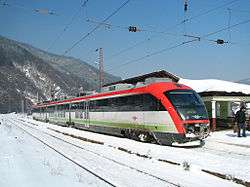
In 2005 and 2006, the Bulgarian State Railways began operating Desiro trains as part of a 67 million Euro deal with Siemens AG for a total of 25 Diesel multiple units.[2] As of 22 March 2006, 16 trains had been delivered, with many of them operating on the Sofia-Kyustendil-Sofia line. Another 117 million Euro deal for 25 EMUs has also been signed with Siemens AG. The EMUs were fitted out in Varna, where BDZ and Siemens AG are intending to establish a joint venture company. The EMUs are designated classes 30 and 31 and are servicing traffic in the Sofia and Plovdiv areas.
Czech Republic
Private railway company Arriva vlaky operates with two Desiro trains borrowed from Deutsche Bahn (DB).[3]
Denmark
In Denmark DSB has rented 12 Desiro trains since 2002. The trains are primarily used between Odense and Svendborg and between Odense and Fredericia. On 2 July 2009 DSB signed a contract of eight trains from Siemens for Grenaabanen, which entered service on 12 December 2010, with an option for 92 more.[4] The trains extend to Odder from December 2012, starting the light rail network in Aarhus city.[5]
Nordjyske Jernbaner used Desiro trains since 2004 on all its operations. Today the company owns eight Desiro trains.
Germany

Germany's Deutsche Bahn introduced two-car Desiro DMUs for local services in 2000. With a top speed of 120 km/h (75 mph), these Class 642 units are mainly used on branch lines and regional lines. Besides the 234 units purchased by DB in 2007, various private German rail companies are also using Desiro DMUs.
The Class 642 is equipped with two MTU diesel engines with an output of 275 or 315 kW (369 or 422 hp) each and hydro-mechanical transmission with retarders. It typically contains 100 seats. When linked together with Scharfenberg couplers, up to three trainsets can be operated together. The Desiros are quite popular with most passengers, thanks to their good acceleration. Because they have often replaced push/pull trains, their shorter journey times, such as on the Müglitz Valley Railway, have encouraged greater passenger numbers.
Originally DB intended to operate together modern DMUs purchased from different manufacturers, but due to software incompatibilities this proved to be impossible. Therefore, the Class 642 can only be mechanically coupled with other DMUs like the Class 643.
Greece
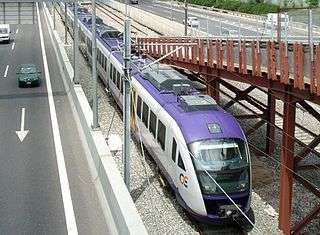
In Greece eight diesel DMU-2 Desiro trains (OSE class 660) were temporarily in service with the Hellenic Railways Organisation (OSE) during 2004–2006, and again in 2007 on the Athens–Chalkida line and on the Athens suburban railway lines (Proastiakos). Afterwards they were returned to their owner (Hellenic Shipyards S.A.) in December 2007. In the late 2008 Hellenic Shipyards/MAN-FERROSTAAL leased the eight units to Hungary with a contract for 20 years.[6]
OSE owns and TrainOSE operates twenty electric Desiro EMU-5 (OSE class 460) equipped for the 25-kV overhead catenary system. They operate on the Athens - Kiato, Athens - Athens International Airport and Athens - Chalkis suburban lines and as a stopping service on the mainline between Thessaloniki and Larissa, which is also advertised as a suburban service. OSE is in litigation with the joint venture of Siemens & Hellenic Shipyards for the supply of those 20 Desiro.
Hungary
At present 31 diesel Desiros are in service with MÁV (including the eight units from Greece), mainly as suburban trains on the regional line between Debrecen - Nagykereki and Budapest - Lajosmizse and as an InterCity between Budapest and Baja. On weekends the units also used as peak inter-city trains from Budapest to Baja and Sátoraljaújhely and as fast trains from Budapest to Tapolca. During the summer months (when fewer units are used on the Budapest suburban routes) Desiros appear on some local train diagram on the north shore of the Lake Balaton.
Malaysia
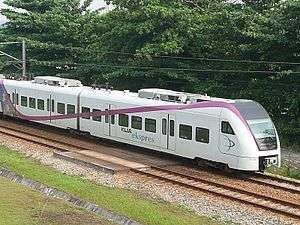
The 57 km (35 mi) Express Rail Link line, an airport rail link service between KL Sentral railway station in central Kuala Lumpur and Kuala Lumpur International Airport to the south, uses the Desiro ET 425 M four-car Electric Multiple Units (which are technically similar to DBAG Class 425 sets in Germany).[7] 12 trainsets are currently in operation: Eight trains are used for the non-stop KLIA Ekspres service between KL Sentral and the airport, while another four trains call at three intermediate stations in between, including one serving Putrajaya. These EMUs have a maximum commercial speed of 160 km/h (99 mph) making them the fastest trains currently operating in Malaysia.
Romania
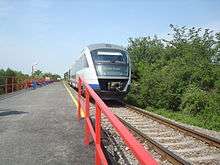
Căile Ferate Române (CFR), Romania's national railway operator, is one of the largest users of the Siemens Desiro trainsets (as the light train variant). CFR, which is currently undergoing modernisation, has bought 120 diesel Desiro trainsets and uses them for both its "Inter Regio", and "Regio" services, but mainly on its "Regio" trains. The trains are nicknamed "Săgeata Albastră" (Blue Arrow). There was some criticism of the use of Desiros for CFR's long-distance services because they were considered to be uncomfortable. CFR has recently refitted them, and is now using Desiros mainly on its medium- and short-distance routes. For example, it is planning to use them as part of a proposed commuter link in Bucharest and Ilfov county. In 2018, CFR announced that they plan to purchase 100 more Desiros, second hand.[8] For more information on routes, see Căile Ferate Române.
Slovenia
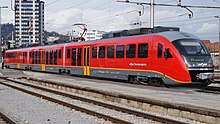
Slovenian Railways operates 30 electric Desiro units that are designated as Desiro EMG 312 SR 31E. They are used as commuter stopping trains on electrified lines, i.e., from Ljubljana to Koper, Jesenice (via Kranj), Maribor and Dobova (via Zidani Most).
United States

The Sprinter light rail system employs VT642 Desiro diesel units. It serves Northern San Diego County, California, United States between Oceanside and Escondido along a 35 km (22 mi) railway line. Twelve married pairs were delivered in August 2006 to the operator North County Transit District (NCTD). Service began on 9 March 2008, serving fifteen stations.
Mountain Rail, one of two competing coalitions bidding on a large portion of FasTracks in Denver, appeared to be proposing a Siemens Desiro ML derived vehicle that is Federal Railroad Administration compliant. Both EMU and DMU units would have been used for the Northwest Corridor, North Metro Corridor and Gold Line. Electric traction was eventually chosen for the project.
Desiro Mainline
Austria
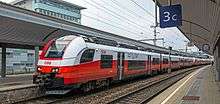
In April 2010 ÖBB signed a framework agreement for up to 200 Desiro ML trains.[9] The first such trains entered service on the Vienna S-Bahn in 2015, branded as cityjet.
Belgium
In 2008 NMBS/SNCB ordered 305 Desiro ML trains.[10] In 2013, the order of the final 250 trains was suspended because of technical problems with the trains already running. The company is seeking damages from Siemens for these problems which caused many delays. Siemens had already been fined €25 million for the late delivery of the first batch of trains.[11] The order for all units was confirmed in 2013 and in March 2015 the last two arrived.
In August 2014 the head of the NMBS/SNCB explained to the newspapers that the Desiro trains need repairing too often, i.e., at a rate of one technical intervention per 8000 kilometers.[12] The trains are used heavily on the Brussels Regional Express Network, but also InterCity lines between Antwerp and Ghent and on lines electrified with 25kV AC in the Belgian Ardennes where they replaced diesel-trains.
Germany
Desiro ML Mittelrheinbahn is used by the private rail operator trans regio for regional services between Cologne and Mainz on the left bank of the Rhine.[13] The EMUs are leased from Angel Trains and received the class number 460 by the Eisenbahnbundesamt, the federal railway authority (the unpowered middle carriages have the class number 860). The 15 kV AC overhead line EMUs have a top speed of 160 km/h (99 mph); however they are limited by the EBA to 150 km/h (93 mph) on account of insufficient braking power from 160 km/h (99 mph). All cars use conventional bogies and additional middle carriages can be added later.
Desiro RUS
Russia
Desiro RUS, designated ES1, is 1,520 mm (4 ft 11 27⁄32 in) broad gauge electric commuter and regional train developed for Russian railways, which calls them Lastochka (English: Swallow).[14]
In January 2013 RZD began putting into service the first 18 trains from the initial order for 38. In mid-2013 a joint venture between Siemens and Ural Locomotives began production of the second batch of 16 trains at a factory in Ekaterinburg. The first train was assembled in June 2014. 62% of its components were produced locally. The factory is expected to supply 240 trains by 2021.[15]
In 2011 RZD ordered 1,200 cars from Ural Locomotives. Local content is to be increased to 80 percent. Siemens also has an order for maintenance of rolling stock for a period of 40 years. The contracts with the Siemens is estimated at 2.5 billion euros.
ES2G is an urban version being used since 2016 on the ![]()
A total of 207 trainsets of all Lastochka types were delivered as of January 2020.
Desiro UK
Thailand
Nine 25 kV AC Desiro UK EMUs based on the Heathrow Connect Class 360/2 are used for the Suvarnabhumi Airport Link which provides express and local services between Phaya Thai Station and Suvarnabhumi Airport.[16]
United Kingdom
Siemens uses the name Desiro UK for the DMU and EMU trains operated by various United Kingdom train operators. These trains have a completely different design to the lighter Desiro Classic variant. The trainsets have modern equipment such as toilet waste retention tanks, ergonomic seats, and automated information displays with spoken announcements.
| Class | Image | Operator | Introduced | Number | Power | Carriages | Door configuration | Car length | End gangways |
|---|---|---|---|---|---|---|---|---|---|
| Class 185 | 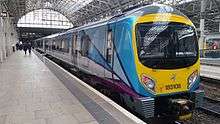 | TransPennine Express | 2006 | 51 | Diesel-Hydraulic | 3 | High-volume | 23 m (75 ft 6 in) | No |
| Class 350/1 |  | West Midlands Trains | 2004 | 30 | AC/DC electric | 4 | 20 m (65 ft 7 in) | Yes | |
| Class 350/2 | 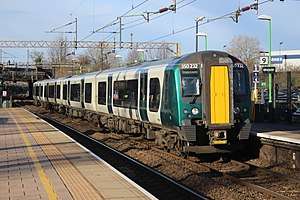 | 2008 | 37 | AC electric | |||||
| Class 350/3 | 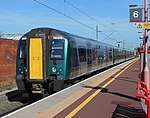 | 2014 | 10 | ||||||
| Class 350/4 | 2013 | 10 | |||||||
| Class 360/1 | .jpg) | Greater Anglia | 2003 | 21 | No | ||||
| Class 360/2 | 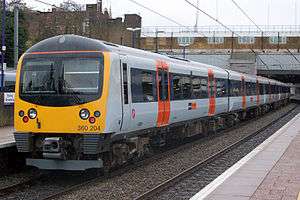 | TfL Rail | 2005 | 5 | 5 | ||||
| Class 380/0 | ScotRail | 2010 | 22 | 3 | 23 m (75 ft 6 in) | Yes | |||
| Class 380/1 | 16 | 4 | |||||||
| Class 444 | 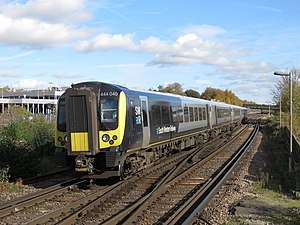 | South Western Railway | 2004 | 45 | DC electric | 5 | Low-volume | ||
| Class 450 |  | 2003 | 127 | 4 | High-volume | 20 m (65 ft 7 in) |
EMUs
The first electric Desiro UK units were ordered by South West Trains for both short- and long-distance service out of London Waterloo to Alton, Basingstoke and the Hampshire/Dorset coast, to replace its Mark 1 slam door EMUs, which were due for replacement as most were more than 40 years old and did not meet modern health and safety requirements. They became two different classes, both of which use the 750 V DC third-rail power supply. One hundred and ten Class 450 four-car units for commuter services entered service in 2003, and 45 Class 444 five-car units for long-distance inter-city services entered service in 2004. An additional order for a further 17 Class 450 units was placed, with the trains in service by late 2006 and early 2007.[17][18][19]
First Great Eastern acquired 21 Class 360 four-car units which operate from 25 kV overhead electrical supply for services from London Liverpool Street to Clacton-on-Sea and Ipswich. These entered service in 2003.[20]
Heathrow Connect ordered five Class 360 four-car units for the stopping service between London Paddington and Heathrow Airport.[21] They were converted from a speculative Class 350 order made by Angel Trains.[22] They were later increased to five cars.[23]
As part of the modernisation of the West Coast Main Line, the Strategic Rail Authority (SRA) ordered 30 Class 350 dual-voltage sets for use on stopping services by Central Trains and Silverlink.[24] They are operated by West Midlands Trains. These units were originally ordered as Class 450 third-rail units for South West Trains, but following a review by the SRA they were diverted to the West Coast. The dual-voltage capability has only been used in service on temporary loan to Southern on Milton Keynes Central to East Croydon services whilst covering for a shortfall of Southern Class 377 units.[25] In 2008/09 a further 37 Class 350/2 four-car units entered service with London Midland followed by 10 Class 350/3s in 2013.[26] First TransPennine Express took delivery of 10 Class 350/4s in 2013.[27]
First ScotRail ordered 22 three-car and 16 four-car Class 380 EMUs.[28] Entry to service began 8 December 2010. They replaced the Class 318 and Class 334 "Juniper" fleets on the Inverclyde Line and Ayrshire Coast Line. The Class 322 trains on the North Berwick line were also replaced by the new units.
DMUs
To fulfil their franchise commitment, First TransPennine Express ordered the first diesel variant of the Desiro UK for use on its inter-city services across the north of England and over the border in southern Scotland. 51 three-car units designated as Class 185 entered service in 2006.[29]
Desiro City
Desiro City is a high-capacity commuter EMU for the UK market building on the Desiro UK and Desiro Mainline, with a reduction in weight and energy use, and with 'fly-by-wire' controls.[30]
A £1.6 billion order for 115 eight-car and twelve-car units (1,150 vehicles) for the Thameslink rolling stock programme was awarded in 2011 and finalised in 2013. The vehicles were given the designation Class 700.
In 2014, South West Trains ordered 30 Class 707 five-car units, at a cost of £210 million.[31]
| Class | Image | Operator | Introduced | Number | Power | Carriages | Door configuration | Car length | End gangways |
|---|---|---|---|---|---|---|---|---|---|
| Class 700/0 | 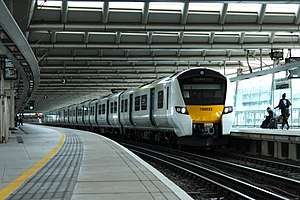 |
Thameslink | 2015-18 | 60 | AC/DC electric | 8 | High-volume | 20 m (65 ft 7 in) | No |
| Class 700/1 | 55 | 12 | |||||||
| Class 707 | South Western Railway | 2017-18 | 30 | DC electric | 5 | ||||
| Class 717 |
|
Great Northern | 25 | AC/DC electric | 6 | Emergency only |
Desiro HC
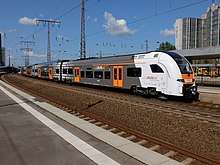
At InnoTrans 2014, Siemens presented its Desiro High Capacity (Desiro HC) offering. The Desiro HC consists of single deck motor cars with up to four intermediate double deck coaches, which combines accessibility with capacity.[32]
Germany
In April 2015, Siemens announced that it had won a tender[33] to build a fleet of 82 Desiro HC trains for the Rhine-Ruhr Express (RRX) project in Germany.
Israel
In September 2017, Israel Railways announced that Siemens was the successful bidder in a tender for 60 Electric Multiple Unit sets (for a total of 330 carriages) to be delivered starting in 2020. Under the contract, Siemens will supply Israel Railways with Desiro HC trainsets at a value of US$910 million with options for additional units to be supplied in the future. Siemens will also build a $65 million maintenance depot in Ashkelon and maintain the first 24 trains for the sum of $114 million, with an option for Israel Railways to increase the number of trains under Siemens’ maintenance later.[34][35]
Desiro Double Deck
A low-floor, double-deck multiple unit.[1]
Switzerland
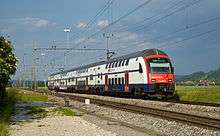
Swiss Federal Railways operates double-decker, or bilevel, EMUs designated as class SBB RABe 514. They are used as commuter trains in Zürich, as part of the Zürich S-Bahn, where 61 four-car sets have been in operation since 2006.
References
- "Desiro". Siemens.
- "Bulgarian modernisation programme aims to win back lost traffic". Railway Gazette International. 1 March 2005.
- https://www.arriva.cz/cs/o-spolecnosti/novinky/siemens-desiro-na-lince-s49-11058
- "DSB agrees Desiro DMU framework contract". Railway Gazette International. 3 July 2009.
- Østergaard, Nicolai (7 December 2012). "Trods spritnye tog: Århus-pendlere får længere rejsetid". Ingeniøren. Retrieved 7 December 2012.
- "World rolling stock market February 2009". Railway Gazette International. 14 February 2009.
- Siemens - Express Rail Link Kuala Lumpur Archived 20 July 2006 at the Wayback Machine
- "CFR Călători va cumpăra în leasing 100 de automotoare rulate Desiro" (in Romanian). 4 July 2018. Retrieved 24 December 2018.
- Desiro ML framework to meet ÖBB's expansion plans. Railway Gazette International 20 April 2010.
- "Na Italiaanse ook Duitse treinellende voor NMBS". De Standaard. 11 December 2013.
- "Belgian rail refuses to accept German trains". VRT De Redactie. 12 February 2013.
- Les nouveaux trains Desiro, pas fiables?, La Libre Belgique, 13 August 2014
- "Sinara and Siemens announce Desiro production agreement". Railway Gazette International. 1 June 2011.
- "Немцы доехали до Москвы". Эксперт. 16 June 2014.
- Bangkok Airport Express to change city travel. Railway Gazette International 1 December 2005.
- SWT Class 450s enter service Entrain issue 28 December 2003 page 15
- South West Trains launches Fab 444s at Waterloo Rail issue 489 9 June 2004 page 9
- DfT confirms order for more 450s for SWT Today's Railways UK issue 53 May 2006 page 56
- Desiro makes its FGE debut run Rail issue 468 20 August 2003 page 8
- Take off! New Heathrow Connect targets airport staff Rail issue 516 22 June 2005 page 8
- 360s to use old bodies Rail issue 484 31 March 2004 page 24
- Fifth coaches arrive for Hex 360s Today's Railways UK issue 62 February 2007 page 62
- New West Coast 350s enter service Entrain issue 44 August 2005 page 56
- 350s with Southern until November Today's Railways UK issue 95 November 2009 page 65
- 37 Desiros on the way in £164m Midlands deal Rail issue 573 29 August 2007 page 12
- New 350s in sight for London Midland and TransPennine The Railway Magazine issue 1327 November 2011 page 83
- New Electric Trains for Scotland's Growing Railways Archived 17 December 2009 at the Wayback Machine, Transport Scotland press release 11 July 2008
- TPE Class 185 Desiro enters TransPennne traffic Rail issue 539 29 March 2006 page 6
- "Siemens offers Desiro City to the UK market". Railway Gazette International. 17 July 2009.
- "Siemens wins South West Trains suburban EMU order", www.railwaygazette.com, 3 September 2014
- https://assets.new.siemens.com/siemens/assets/api/uuid:ec908e62e42e0499dfddc3c43b2fbf244e5ced21/version:1564395666/mo-desiro-hc-broschuere-en-preview.pdf
- "Billion-euro order: Siemens to build Rhine-Ruhr express – 82 Desiro HC".
- "Siemens selected for Israel Railways EMU order". Railway Gazette. 28 September 2017. Retrieved 4 October 2017.
- Goldberg, Jeremaya (28 September 2017). "Siemens chosen for $US 1bn Israeli EMU order". International Railway Journal. Retrieved 4 October 2017.
External links
| Wikimedia Commons has media related to Siemens Desiro. |
- Desiro at Siemens website
- Interactive 360° virtual tour of a Desiro ML
